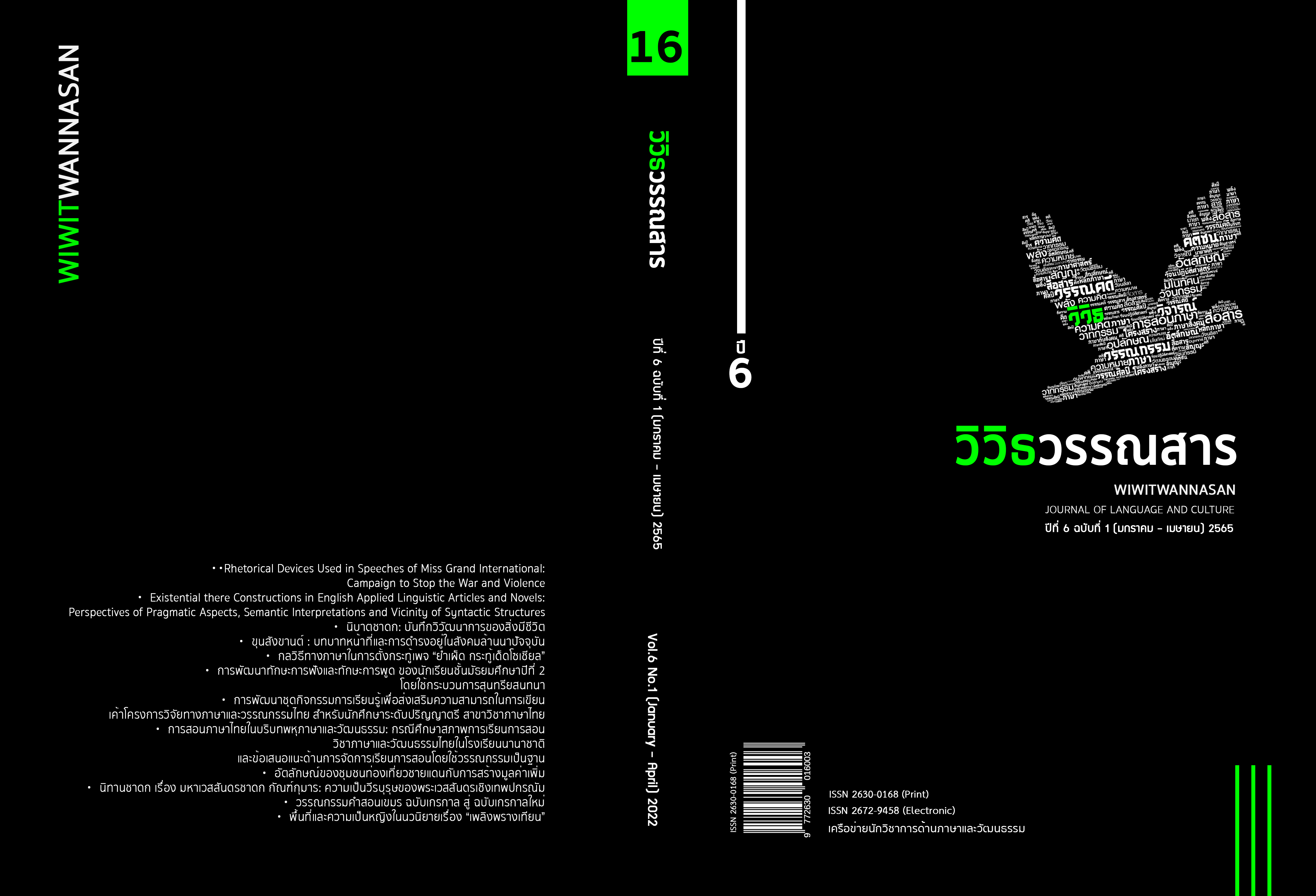Rhetorical Devices Used in Speeches of Miss Grand International: Campaign to Stop the War and Violence
Main Article Content
Abstract
In the present time, there are many beauty pageants that are interested by young women around the world, and Miss Grand International is one of well-known beauty pageants that allows the contestants to give speeches to stop the war and violence. Within the speeches, the use of rhetorical devices appears in the speeches. The aim of this research was 1) to study the rhetorical devices used in the Miss Grand International and 2) to analyze rhetorical devices used in the Miss Grand International to stop the war and violence campaign speeches. The data were collected from video clips and transcribed into the written language from forty-six English speeches. The clips in this research used a purposive sampling between 2014 and 2018. The theoretical frameworks of rhetorical devices were employed from the work of Harris (2016), and Michalik and Michalska-Suchanek (2016). The study found that the five most frequent use of rhetorical devices in speeches were Pronouns, followed by Parallelism, Adjective (Degree), Anaphora and Rhetorical Questions. Furthermore, Synecdoche, Simile and Epanalepsis were the three types of rhetorical devices that were the least used. The data analysis shows that in the campaign to stop the war and violence has rhetorical devices in the speeches which influence audiences’ thoughts and views. These findings tend to indicate the importance of using rhetorical devices could affect the attitudes and opinions of the audiences.
Article Details

This work is licensed under a Creative Commons Attribution-NonCommercial-NoDerivatives 4.0 International License.
Copyright is that of the journal any reproduction must be permitted by the editor of journal
References
Aboulela’s novel “The Translator”. American International Journal of Contemporary Research, 5(1), 29-38.
Bowers, E. (2016). Social stereotyping and self-esteem of Miss America pageant
contestants. (Doctoral Dissertation). Walden University, Minnesota.
Chetia, B. (2015). Rhetorical devices in English advertisement texts in India: a descriptive
study. International Journal of Social Science and Humanity, 5(11), 980-984.
Cirugeda, I. L., & Ruiz, R. S. (2013). Persuasive rhetoric in Barack Obama’s immigration speech:
pre-and post-electoral strategies. Camino Real, 5(8), 81-99.
Cui, Y. & Zhao, Y. (2014). Translation of rhetorical figures in the advertising discourse: a case
study. International Journal of Society. Culture & Language IJSCL, 2(2), 57-67.
Farrokhi, F., & Nazemi, S. (2015). The rhetoric of newspaper editorials. International Journal
on Studies in English Language and Literature, 3(2), 155-161, 155-161.
Fengjie, L., Jia, R. & Yingying, Z. (2016). Analysis of the rhetorical devices in Obama’s public
speeches. International Journal of Language and Linguistics, 4(4), 141-146.
Harris, R. (2013). A handbook of rhetorical devices. Delaware: Prestwick House.
Khomkamnak, K., Damma, P., Payomrat, I., Takimnok, K. & Angkunsinthana, N. (2019). Cheewit
Tit Review: The language of persuasion in food page. Fa Nuea Journal Faculty of Humanities Chiang Rai Rajabhat University, 10(2), 25-45. (In Thai).
Krudtnet, P. & Choochart, P. (2020). Language usage for persuasion in home advertisement
on Facebook’s property firms. Vacana Journal, 8(2), 25-43. (In Thai).
Legget, B. & Rosanas, J. M. (2008). Rhetoric and persuasion in management. Barcelona:
IESE Business School, University of Navarra.
Liu, Z., Xu, A., Zhang, M., Mahmud, J., & Sinha, V. (2017). Fostering user engagement:
rhetorical devices for applause generation learnt from TED Talks. Proceedings of the Eleventh International AAAI Conference on Web and Social Media, 592-595.
Mayuuf, H. H. (2015). Rhetorical pragmatics. Journal of Advanced Social Research. 5(5), 19-
38, 19-38.
Michalik, U. & Michalska-Suchanek, M. (2016). The persuasive function of rhetoric in
advertising slogans. Journal of Accounting and Management, 6(1), 45-58.
Miss Grand International. (2016). Retrieved October 23rd 2019 from
http://www.missgrandinternational.com/.
Naksawat, C., Akkakoson, S. & Loi, C. K. (2016). Persuasion strategies: use of negative force in
scam e-mails. GEMA Online Journal of Language Studies, 10(1), 1-17. (In Thai).
Peeples, J. (2015). Discourse/ rhetorical analysis approach to environment, media, and
communication, The Routledge Handbook of Environment and Communication Routledge. Retrieved April 4th 2020 from https://doi/10.4324/9781315887586.ch3.
Plodmusik, W. & Common, T.B. (2018). The communication of beauty identity through
Miss Grand Thailand contest. Journal of Communication Arts, 38(2) May-August 2018, 34-51.
Sukdarunpattha, T. & Iamratanakul, S. (2017). The beauty pageants’ image to society,
Kasetsart Applied Business Journal (Thailand), 11(14), 38-52. (In Thai).
Taping, M. G., Juniardi, Y., & Utomo, D, W. (2017). Rhetorical devices in Hillary Clinton
concession speech, The Journal of English Language Studies, 2(2), 225-240.
Tom, G. & Eves, A. (1999). The use of rhetorical devices in advertising, Journal of Advertising
Research, July-August, 39-43.
Tonawanik, P. (2015). Rhetorical figures in taglines: MaQuarrie and Mick’s Classification.
Suthiparithat, 29(90), 112-129.
Valiantien, N. M. (2015). Emma Watson’s magic spell in gender equality: the use of rhetorical
devices in “Heforshe” campaign. Calls. 1(2), 45-55.
Wirunmat, S. & Chantawerot, T. (2018). Perception on marketing communication affecting
image of Miss Grand Thailand beauty pageant. Proceedings of the 13th Graduate Research Conference 2018 (pp.2052-2060). Pathum Thani: Rangsit University.
(In Thai).
Wongthai, N. (2013). A study of beauty discourse on beauty drinks advertisements. Journal
of Humanities, 20(1) January-June 2013, 77-107. (In Thai).
Young, R. O. (2017). Persuasive communication. New York: Routledge.
Zulkipli, M. F. & Ariffin, A. (2019). Understanding the roles of rhetorical devices and
intertextuality in promotional discourse. International Journal of Heritage, Art and Multimedia, 2(5), 90-107.


